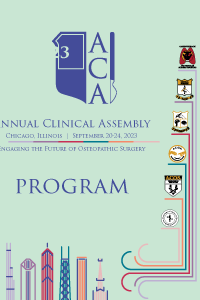Urological Surgery
Therapeutic Management of Metastatic Renal Cell Carcinoma with Pembrolizumab Plus Axitinib: Rare Case of A Pathological Complete Response
- RW
Ryan Wong, B.S.
Nova Southeastern University
Plantation FL, Florida, United States
Primary Presenter(s)
Renal cell carcinoma (RCC), deriving from the renal tubular epithelia, is the most common type of renal neoplasm. It accounts for roughly 2% of all cancer cases and is often detected incidentally upon imaging.1 Patients with RCC may present with symptoms such as hematuria, flank pain, a palpable mass. Additionally, approximately 30% of RCC cases with localized primary tumors will develop metastatic disease, often metastasizing to the lung, liver, and bones.2,3 The 5-year survival rate of metastatic RCC (mRCC) is 12%, although improving steadily with the advent of combination immunotherapy-based treatments.1
One option for systemic treatment approved by the FDA for initial treatment of mRCC is the combination of pembrolizumab and axitinib.4 The randomized, open label, phase 3 KEYNOTE-426 trial demonstrated an improvement in overall survival with this combination compared with prior standard of care (sunitinib).5 Pembrolizumab is an immunotherapy drug that blocks the PD-1 receptor, thereby enhancing the immune response against cancer cells. Axitinib is a targeted therapy drug that inhibits the activity of the vascular endothelial growth factor receptor (VEGFR), thereby reducing the blood supply to tumors and slowing their growth. The role for cytoreductive nephrectomy after systemic therapy with pembrolizumab and axitinib is not well defined, but some patients undergo this surgery after an initial cancer response to consolidate therapy and render them disease free, or to alleviate symptoms.
Our present case represents a rare incidence of a pathological CR of mRCC following treatment with pembrolizumab plus axitinib. This concurs with only a few cases in the literature that have documented this treatment success.6,7 This underscores the potential of this treatment regimen in selected patients with mRCC and the need for further research to optimize clinical decision-making and treatment outcomes.
Methods or Case Description:
A 57-year-old male is referred for an evaluation of mRCC to the lung after presenting with a cough. He has a past medical history of GERD. His labs on presentation were significant for high calcium (10.3 mg/dL), low hemoglobin (13.3 g/dL), low absolute lymphocytes (1.0x10^9/L). His social history includes prior heavy alcohol use of 10-15 beers per day, prior smoking with a 40-pack year history, and no injected drug use. The patient has no family history of cancer.
On presentation, CT of the abdomen revealed a large renal mass in the upper pole of the right kidney with associated thrombus. Staging PET-CT revealed hypermetabolic activity in the upper pole of the right kidney with suprarenal IVC extension and a hypermetabolic right pulmonary nodule.
Follow up CT confirms a large right renal mass with IVC invasion and multiple retroperitoneal lymph nodes (para-aortic LAD) with possible early hepatic invasion. Subsequent MRI of the abdomen shows a heterogeneously enhancing 11.4 x 12.2 x 13 cm mass compatible with RCC in the upper pole of the right kidney with extensive venous invasion. The tumor occludes the IVC and extends to hepatic IVC level. Three indeterminate subcentimeter arterially enhancing liver lesions and a 1.2 cm right middle lobe lung nodule is also observed. Right middle lobe lung biopsy confirms mRCC with a clear cell histology.
The patient received pembrolizumab 400 mg IV every six weeks plus axitinib (5 mg twice daily) per KEYNOTE-426.
Outcomes:
The patient had typical side effects of VEGFR tyrosine kinase inhibitor therapy with hypertension, diarrhea, bloating, and mouth tenderness. Axitinib dose was decreased to 3 mg twice daily and then 2 mg twice daily with subsequent improvement in his symptoms.
After two years of systemic treatment, CT of the right upper pole renal mass shrunk to 6.2 x 4.5 cm with persistent invasion into the left renal vein and infrahepatic IVC. His lung nodule was no longer measurable. He therefore underwent open right radical nephrectomy including adrenalectomy, liver mobilization and partial hepatectomy, along with IVC ligation and resection. Patient was discharged post-operative day four with an unremarkable inpatient stay.
Pathology report revealed no viable carcinoma on nephrectomy, IVC thrombectomy, and partial hepatectomy specimen. This was consistent with a pathological CR from pembrolizumab plus axitinib. One-month post-operative labs revealed normal calcium, elevated creatinine (1.65 mg/dL), decreased eGFR CKD-EPI (2021) Male (48 mL/min/1.73m2), and decreased albumin (3.3 g/dL).
Conclusion:
This case report describes a rare occurrence of pathological CR of mRCC to the lung with the use of pembrolizumab plus axitinib. Despite the patient's experience with gastrointestinal symptoms and VEGF-induced hypertension, his symptoms were effectively managed during the therapy and resulted in a significant response. This case suggests that further investigation may be warranted for pembrolizumab plus axitinib treatment in achieving pathological CR of mRCC besides the lung. This case also highlights the potential benefit of withholding cytoreductive nephrectomy before systemic treatment in patients having mRCC and primary tumor invasion of the IVC.

